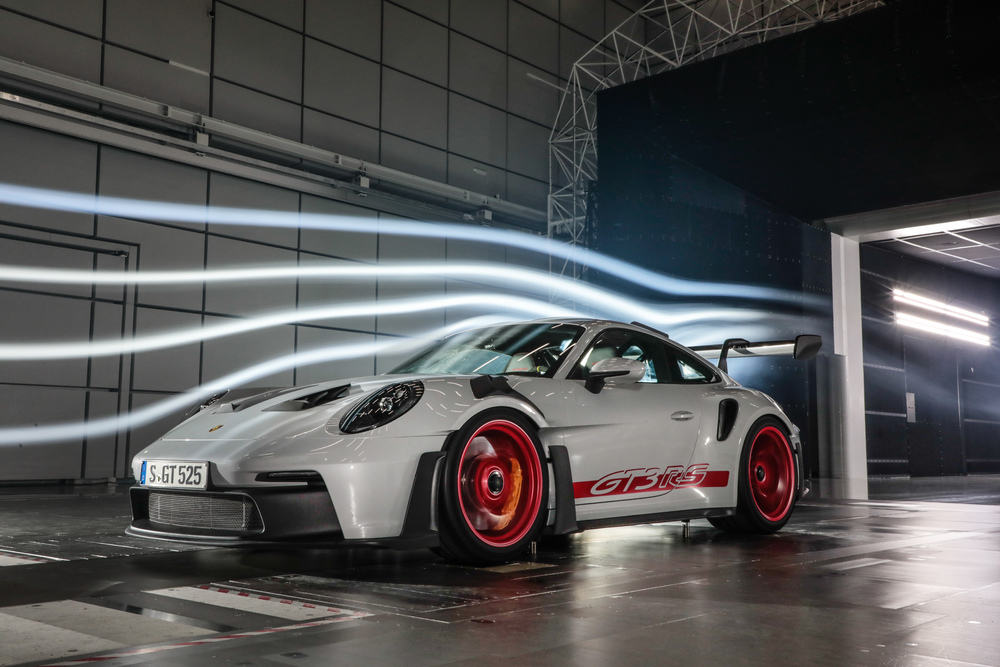2022 Porsche 911 GT3 RS: Here's everything you need to know
For the first time, the spoiler sits higher than the roof on a Production Porsche

After much anticipation, Porsche has unleashed the new 911 GT3 RS which is uncompromisingly designed for maximum performance.
The look of the new 911 GT3 RS is characterised by the large number of functional aerodynamic elements, with the most prominent feature of the GT sports car is the swan-neck-supported rear wing, which is significantly larger in all dimensions.
The rear wing consists of a fixed main wing and an upper, hydraulically adjustable wing element. For the first time on a Porsche production vehicle, the upper edge of the rear wing is higher than the car’s roof.

In addition, the front end of the 911 GT3 RS no longer has a front spoiler, but instead features a front splitter that divides the air flowing over and underneath.
While the inlets behind the front wheels in the style of the iconic Le Mans-winning 911 GT1 reduce the dynamic pressure in the wheel arches, the sideblades behind the intake ensure that the air is directed to the side of the vehicle.
A drag reduction system (DRS) is also fitted in a production Porsche for the first time. To achieve low drag and higher speeds on straight sections of the track, the DRS allows the wings to be flattened out at the push of a button, within a specific operating range.

Powered by a 4.0-litre high-revving naturally aspirated 525 PS engine, the new 911 GT3 RS takes full advantage of technology and concepts from motorsport.
Even beyond the high-revving naturally aspirated engine with racing DNA and intelligent lightweight construction, it is, above all, the cooling and aerodynamic systems of the 911 GT3 RS that connect it most directly with its motorsport brother, the 911 GT3 R.
Paired with the aforementioned engine is a seven-speed Porsche Doppelkupplung (PDK) which has a shorter overall gear ratio than the 911 GT3. Thanks to the powertrain, the 911 GT3 RS accelerates from zero to 100 km/h in 3.2 seconds and reaches a top speed of 296 km/h in seventh gear.
Instead of the three-radiator layout seen in previous cars, the new 911 GT3 RS relies on a large, angled centre radiator in the car’s nose, positioned where the luggage compartment is located on other 911 models.

Even the suspension comes in for aerodynamic attention. Because the wheel arches of the new 911 GT3 RS are subject to powerful airflows, the components of the double-wishbone front axle are designed with teardrop-shaped profiles.
The 911 GT3 RS offers three driving modes - Normal, Sport and Track. In Track mode, the basic settings can be individually adjusted. Among other settings, the rebound and compression damping of the front and rear axles can be adjusted separately and in several stages.
The rear differential can also be adjusted via rotary controls on the steering wheel. This is done quickly and intuitively with an operating and display concept also borrowed from motorsport: Four individual rotary controls and a button for the Drag Reduction System (DRS) are located on the steering wheel.

At the touch of a button, the driver can reduce the digital displays on the two seven-inch side displays to essential information only. The gearshift indicators to the left and right of the analogue tachometer have also been taken from the GT3.
Thanks to an array of lightweight construction measures such as the extensive use of CFRP, the 911 GT3 RS weighs in at only 1,450 kg (kerb weight according to DIN) despite many larger components. The doors, front wings, roof and front lid, for example, are made from CFRP. Lightweight CFRP is also used in the interior, for example in the standard full bucket seats.
Inside, the new 911 GT3 RS is finished in black leather, Racetex and carbon-weave finish characterise the purist, sporting ambience. The 911 GT3 RS is available with the Clubsport package at no extra cost. This includes a steel rollover bar, a hand-held fire extinguisher and six-point seat belts for the driver.

The Weissach package, which is available at extra cost, involves considerably more. The front lid, roof, parts of the rear wing and the upper shell of the exterior mirrors feature a carbon-weave finish.
Last but not least, Porsche’s own watchmaking operation in Solothurn, Switzerland, has developed the 911 GT3 RS chronograph mechanical watch which is reserved for owners of the car.










